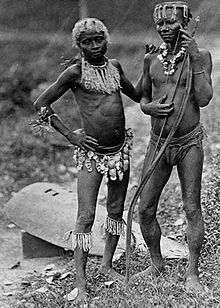Andamanie
Andamanie, Andamańczycy – rdzenni mieszkańcy indyjskiego archipelagu Andamany.
Dzielą się na kilka plemion i posługują kilkoma różnymi językami. Największe grupy stanowią plemiona Onge na Małym Andamanie, Jarawa na Andamanie Południowym (około 750 osób) i Sentinelczycy na wyspie Sentinel Północny (100–300 osób). Antropologicznie bliscy są Melanezyjczykom.
Są koczownikami. Do ich tradycyjnych zajęć zalicza się rybołówstwo, zbieractwo i połów żółwi morskich, w lasach także myślistwo. Do niedawna Andamanie nie umieli krzesać ognia. Obecnie ich tradycyjny styl życia ulega zmianom pod wpływem imigrantów z kontynentu.
Andamanie przetrwali dzięki stawianiu zaciekłego oporu obcym żeglarzom. Do czasów współczesnych notowane są przypadki ostrzeliwania z łuków (nawet zatrutymi strzałami) podpływających łodzi – ostatnie takie przypadki zanotowano na Sentinelu Północnym[1].
Religia Andamanów obejmuje wierzenia animistyczne i kult bóstw monsunowych.
Przypisy
- ↑ Żegnaj Afryko – witaj Azjo, „Świat Nauki”, marzec 1999, s. 10.
Bibliografia
- Krystyna Damm, Aldona Mikusińska (red.), Ludy i języki świata, Warszawa: Wydawnictwo Naukowe PWN, 2000 (PWN Leksykon), s. 18, ISBN 83-01-13070-9, OCLC 830240260 (pol.).
Media użyte na tej stronie
"One of the earliest existing photographs of Great Andamanese known: two men of an unidentified northern tribe. The man on the left is wearing a traditional cincture decorated with shells . The other on the right is wearing a piece of imported cloth along with more traditional strings - and this only 7 years after the British had set up shop in the Andamans at a time when only very few northern Great Andamanese had had any direct contact with the outsiders yet. How and where this picture came to be shot is unknown. It is possible that the British photographer insisted that the man on the left covered himself with the imported cloth for reasons of modesty.
The hairstyle of the man on the right is not otherwise known among Andamanese. The man of the left has smeared his hair with clay (probably ochre) which was a common practice. The photograph is obviously staged, with a sounding board carefully arranged in the background. This is the only photograph of such board in a northern Andamanese context."
Citation from Clothes, Clay and Beautycare (of Great Andamanese people), by George WeberA couple of the "great Andamanese" population, one of the 5 indigenous population of negritos from andaman islands (great Andamanese ; Jangil ; Jarawa ; Onge ; Sentinelese).



